#ngwevu
Text
Round One: Ngwevu vs Kholumalumo
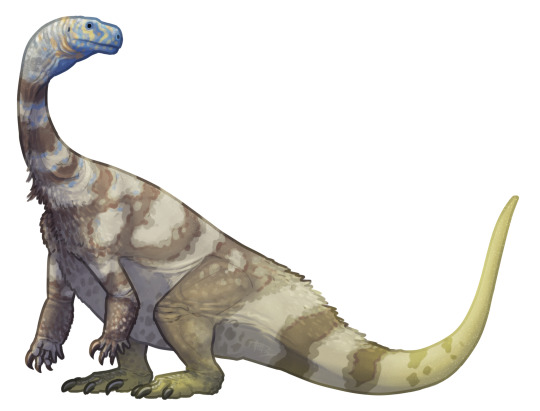

Factfiles:
Ngwevu ntoloko

Artwork by @i-draws-dinosaurs, written by @i-draws-dinosaurs and @zygodactylus
Name meaning: Grey skull
Time: ~190 to 180 million years ago (Pliensbachian to Toarcian stages of the Early Jurassic)
Location: Clarens Formation, South Africa
Ngwevu is a dinosaur with a case of baby-face so bad it was classified as another genus for 40 years. Initially discovered in 1978 and thought to be a specimen of Massospondylus, turns out it was just a really baby-looking prosauropod of a different kind! Many times in evolution animals will retain “baby” characteristics into adulthood - the classic and easily recognizable trait being large, round eyes, but also other features such as stunted proportions and chunkier limbs, depending. It seems that Ngwevu went through one of these processes, looking more similar to juveniles of other prosauropods (such as Massospondylus) than adults, all while actually being adults themselves. Predictably, it had a squat face with large eyes, a wide snout, robust proportions, and a thick body - babified Massospondylus! It probably had a more generalist diet than its cousin, indicating probable niche partitioning as the two lived in the same environment. The Clarens Formation, coming right after the Elliot, was an arid desert dominated by dunes, with a few types of dinosaurs including ornithischians, theropods, and other sauropodomorphs. In addition, fish, crustaceans, and invertebrates are also known from this location.
Kholumolumo ellenbergerorum

Artwork by @alphynix, written by @i-draws-dinosaurs
Name meaning: Kholumolumo (giant reptilian dragon from Sotho folklore) named for Paul and François Ellenberger (the original excavators of the fossils)
Time: 210 million years ago (Norian stage of the Late Triassic)
Location: Lower Elliot Formation, Lesotho
Kholumolumo is an old friend with a new name. Its previous informal name, “Thotobolosaurus” meaning “trash heap reptile”, was truly magnificent and became one of the great memes of Ye Olde 2010s Palaeo Tumblr! Needless to say it was a bittersweet moment to see our old buddy finally published but lose its iconic name in the process. Rest in peace, Trash Heap Lizard.
The reason it wound up with that name is because the fossils were in fact found basically right next to the local rubbish dump of the village of Maphutseng in 1955. The trash pile turned out to be sitting on a bone bed of around five to ten animals, and over the course of several years they were excavated and moved to the University of Cape Town. Unfortunately, and perhaps appropriately to the name, the subsequent study of these fossils ended up being a complete trash fire. Specimens went missing that have never been found, professional relationships fell apart, and the animal itself wasn’t mentioned in the literature until 1970 when it was dropped into a discussion on the stratigraphy of the Elliot formation and named “Thotobolosaurus mabeatae” without any description of the fossils. This made the name “Thotobolosaurus” a nomen nudum (naked name) and thus invalid.
Finally in 2020 all the tribulation paid off and it received a proper initial description, although many fossils that weren’t lost in the chaos still remain under study and could be the subject of future papers. It’s nice to see our beloved trash heap of a dinosaur finally coming into its own!
DMM Round One Masterpost
#dmm#dinosaur march madness#dmm round one#dmm rising stars#palaeoblr#dinosaurs#paleontology#bracket#march madness#polls#ngwevu#kholumalumo
170 notes
·
View notes
Text
Rugby World Cup heartbreak for Springbok Girls as Fiji snatch win on the dying
Bok Girls captain Nolusindiso Booi tackles Fiji’s Merevesi Ofakimalino in the course of the Pool C Rugby World Cup match at Waitakere Stadium in Auckland. (Photograph by Greg Bowker/Getty Pictures)
The Springbok Girls crashed out of the Girls’s Rugby World Cup after a last-gasp 21-17 defeat to Fiji in Auckland on Sunday.
South Africa thought they’d snatched victory when flyhalf Libbie Janse van Rensburg kicked a surprising 79th minute penalty to place her aspect 17-14 forward.
Nonetheless, Fiji reclaimed possession from the restart and managed to pressure their method over, with No 8 Karalaini Naisewa barging over beneath the posts with the final transfer of the sport, breaking South African hearts.
It was courageous efficiency from the SA ladies, who had defended for big elements of the sport. Their resolute defence pissed off Fiji, who squandered a number of scoring alternatives.
South Africa’s two tries have been scored by centre Zintle Mpupha and No 8 Aseza Hele, with Janse van Rensburg changing each tries from beneath the posts.
SA’s defeat on the Waitakere Stadium means their hopes of reaching the quarter-finals are over, having misplaced 40-5 to France of their opening recreation.
The Bok Girls will play England of their last Pool C recreation subsequent Sunday (23 October).
Scorers:
SA 17 (7)
Tries Zintle Mpupha, Aseza Hele
Conversions: Libbie Janse van Rensburg (2)
Penalty: Janse van Rensburg
Fiji 21 (14)
Tries: Ilisapeci Delaiwau, Akanisi Sokoiwasa, Karalaini Naisewa
Conversions: Lavena Cavuru (3)
Springbok ladies’s workforce:
15 Nadine Roos, 14 Nomawethu Mabenge, 13 Zintle Mpupha, 12 Aphiwe Ngwevu, 11 Simamkele Namba, 10 Libbie Janse van Rensburg, 9 Tayla Kinsey, 8 Aseza Hele, 7 Sinazo Mcatshulwa, 6 Sizophila Solontsi, 5 Rights Mkhari, 4 Nolusindiso Booi (captain), 3 Babalwa Latsha, 2 Lindelwa Gwala, 1 Sanelisiwe Charlie
Substitutes: 16 Roseline Botes, 17 Asithandile Ntoyanto, 18 Monica Mazibukwana, 19 Lerato Makua, 20 Lusanda Dumke, 21 Unam Tose, 22 Zenay Jordaan, 23 Eloise Webb
We dwell in a world the place information and fiction get blurred
In occasions of uncertainty you want journalism you’ll be able to belief. For 14 free days, you’ll be able to have entry to a world of in-depth analyses, investigative journalism, high opinions and a spread of options. Journalism strengthens democracy. Make investments sooner or later as we speak. Thereafter you’ll be billed R75 monthly. You possibly can cancel anytime and when you cancel inside 14 days you will not be billed.
Originally published at Irvine News HQ
0 notes
Text
Izithakazelo zakwa Gwala | Gwala Clan Praise
Izithakazelo zakwa Gwala | Gwala Clan Praise
Izithakazelo zakwa Gwala | Gwala Clan Praise
Mphephethwa,
Nzimande,
Khondlwane,
Majiya,
Khamanga,
Mdlovu,
Mantshinga,
Ntimbane,
Ngwede,
Ngwevu,
Jili,
Ngwavuma,
Sihlase,
Vilakazi,
Gcuma,
Ngwekazi,
Mancama ngesinkw’esikhulu,
Wena owasukel’isigodo simuka nomfula uth’inyama,
Manda kulandulwa,
Vilakazi,
Xam’odla ngomsingizane,
Mhlandla!
Zikhona izikibha nama-jacket/hoodies akwa Hlengwa Whatsapp / call: 061 868 5163

View On WordPress
#Gcuma#Izithakazelo#Jili#Khamanga#Khondlwane#Majiya#Mantshinga#Mdlovu#Mphephethwa#Ngwavuma#Ngwede#Ngwekazi#Ngwevu#Ntimbane#Nzimande#Sihlase#VILAKAZI
1 note
·
View note
Link
“The new species, now named "grey skull" in the South African Xhosa language, had originally been categorised as a slightly odd specimen of Massospondylus carinatus, one of many items in the Evolutionary Studies Institute (ESI) collection at the University of the Witwatersrand, South Africa.
More than 40 years after the remains were found, experts have now come to the conclusion that these bones don't belong to M. carinatus at all. Detailed computed tomography or CT scans have revealed key differences between the species.

(Art by: Nobu Tamura)
"This is a new dinosaur that has been hiding in plain sight," says palaeontologist Paul Barrett from the Natural History Museum in London.
"The specimen has been in the collections in Johannesburg for about 30 years, and lots of other scientists have already looked at it. But they all thought that it was simply an odd example of Massospondylus."
One of the noted abnormalities of the preserved dino bones had previously been put down to a deformed skull, but the latest study showed no signs of breaking or twisting – this is a skull from a different species, not a deformed one.”
#Palaeoblr#Palaeontology#Ngwevu intloko#Dinosaur#News#Sauropod#Prehistoric#Mesozoic#Jurassic#Extinct#Art#Info#Information#Article#Link
252 notes
·
View notes
Text
The new grey skulled sauropodomorph and Mission Jurassic
Dinosaur of the day Polacanthus, an ankylosaur that was described in the 1800s, but no one is sure who named it.
In dinosaur news this week:
After decades of being classified as Massospondylus, “grey skull” has a new name, Ngwevu intloko
Mission Jurassic in North Wyoming could hold over 100 dinosaurs in one square mile
A group of juvenile hadrosaurs was found at Pipestone Creek, near the Philip J. Currie Museum
The Scottish government is working on better protecting the fossils on the Isle of Skye in Scotland
In India, a group of scientists are pushing for a bill that will designate and safeguard fossil sites
In Romania, new dinosaur nests have been found, most likely from a hadrosaur like Telmatosaurus
The Natural History Museum in London has digitized their holotype of Mantellisaurus
The Central Museum of Mongolian Dinosaurs recently opened a new exhibition hall, themed Paleozoic Era
Dinosaur Park in Laurel, Maryland has an open house this summer, on September 7
Trix the T.rex is back in Leiden, at the updated Naturalis Biodiversity Center in the Netherlands
A new project called “On the Trail of Dinosaurs,” will bring the Dinosaur Tracks from the Australian Dampier Peninsula to life
children visiting the North Carolina Museum of Natural Sciences regularly try to help the injured sauropod, giving it hugs and Band-Aids.
South Dakota rancher Kenny Brown recently retired and bequeathed his 1,330 acre ranch to the School of Mines
PLOS One blog has a list of events for National Fossil Day in the US (October 16)
On August 29, the US Postal Service is issuing four new T. rex stamps, with a holographs
Nickelodeon has a new animated series coming out September 14, LEGO Jurassic World: Legend of Isla Nubar
To get access to lots of patron only content check out https://www.patreon.com/iknowdino
For links to every news story, all of the details we shared about Polacanthus, and our fun fact check out https://iknowdino.com/Polacanthus-Episode-248/
Check out this episode!
1 note
·
View note
Text
A New Species Of Dinosaur Thought To Be 4 Metres Long Has Been Discovered

The fossils found in an archaeological museum in South Africa have been discovered to belong to a new species of dinosaurs that were previously unknown. Research on fossils can reveal some mysteries about dinosaurs.
According to the British news agency The Guardian, 30 years of thought to belong to a species called Massospondylus, about 200 million-year-old fossils as a result of detailed investigation revealed that the fossils belong to an unknown species.
According to the information, Paul Barret, a member of the Museum of Natural History in London, and Kimberly Chapelle, a doctoral student, compared the bones with those of other species. As a result of these comparisons, the bones did not match with the other species and were found to belong to a new species.

The dinosaur, called Ngwevu intloko (Gray Skull), is thought to be about 4 meters long and weighs approximately 300 kilograms. This new species, which is generally thought to be a herbivorous species, is thought to eat small herbivores from time to time.
The fossils belonging to this dinosaur species were found on a farm in Fouriesburg, South Africa in 1978. Details of the discovery were published in the biology journal PeerJ.
Read the full article
1 note
·
View note
Text
A 40-year old specimen just turned out to be a totally new dinosaur species
https://sciencespies.com/nature/a-40-year-old-specimen-just-turned-out-to-be-a-totally-new-dinosaur-species/
A 40-year old specimen just turned out to be a totally new dinosaur species

Sometimes the discovery of a new dinosaur species doesn’t require an extensive archaeological dig – it just needs a closer analysis of the dino bones already sitting in the collection of a university. That’s turned out to be case with the newly described Ngwevu intloko.
The new species, now named “grey skull” in the South African Xhosa language, had originally been categorised as a slightly odd specimen of Massospondylus carinatus, one of many items in the Evolutionary Studies Institute (ESI) collection at the University of the Witwatersrand, South Africa.
More than 40 years after the remains were found, experts have now come to the conclusion that these bones don’t belong to M. carinatus at all. Detailed computed tomography or CT scans have revealed key differences between the species.

Fossil bone slices were used to date the dinosaur. (Kimberley Chapelle)
“This is a new dinosaur that has been hiding in plain sight,” says palaeontologist Paul Barrett from the Natural History Museum in London.
“The specimen has been in the collections in Johannesburg for about 30 years, and lots of other scientists have already looked at it. But they all thought that it was simply an odd example of Massospondylus.”
One of the noted abnormalities of the preserved dino bones had previously been put down to a deformed skull, but the latest study showed no signs of breaking or twisting – this is a skull from a different species, not a deformed one.
Through close analysis of M. carinatus records, the team also ruled out the hypothesis that this skull and skeleton were different because of growth patterns. Differences between males and females were also discounted, as this typically doesn’t affect skull shape.
By studying slices of bone, the researchers were able to estimate the age of the dinosaur, judging it to be a fully grown adult – and smaller than the typical M. carinatus adult.
“Studying how dinosaurs grew is a very important step in better understanding why some dinosaurs look different,” says palaeontologist Kimberley Chapelle from the University of the Witwatersrand.
“This is a difficult task to accomplish with fossils because it is rare to have a complete age series of fossils from a single species. Luckily, the most common South African dinosaur Massospondylus has specimens ranging from embryo to adult.”
The new categorisation can teach us more about how the world looked at the beginning of the Jurassic period, a little over 200 million years ago, when dinosaurs really began to rule the world.
The newly announced N. intloko dinosaurs would have walked on two legs, with a slender neck and a small, boxy head. At around three metres (almost ten feet) from nose to tail, it would’ve been one of the smaller dinosaurs of its time.

M. carinatus looked like this, and N. intloko was probably similar. (Nobu Tamura/Wikimedia Commons)
The researchers think the dino was primarily a plant eater, though it may have snacked on some small animals that came across its path. All of this makes it very different from the large, plant-eating sauropods that we know from the later Jurassic.
This discovery tells us more about M. carinatus, too: long thought to be a “disaster taxon” (a species thriving in the wake of a natural disaster), this may not be the case. It’s possible that the start of the Jurassic period saw much more diversity than was previously thought, too.
Now the question is whether more M. carinatus specimens have been misidentified – there could well be several N. intloko fossils out there.
“Recent work has now shown that there were actually lots of different types of dinosaurs back then,” says Barrett.
“While we used to think that there was maybe one type of dinosaur, we now know there were actually six or seven sauropodomorph dinosaurs in this area, as well as variety of dinosaurs from other, less common groups.”
The research has been published in PeerJ.
#Nature
0 notes
Text
最新研究發現一種罕見恐龍被錯認30年
據悉,這些骨骸已經在南非約翰內斯堡的一家博物館展出了30多年,在那裡,它們被鑑定為大椎龍屬(Massospondylus)。這是侏羅紀早期的一種恐龍,其曾在2億至1.83億年前在地球上游盪。它是最早被命名的恐龍之一,最初在南非發現後來在萊索托和津巴布韋也出現了它們的身影。
考慮到這些化石的年代,古生物學家斷定,這些骨架之所以形狀怪異則是因為大椎龍死後受到了損壞。除此之外還有一種理論認為,怪異的形狀可能源自恐龍早期奇怪的生長模式。然而,最近一項新的調查卻否定了這些理論。
來自自然歷史博物館(Natrual History Museum)的研究人員發現,這具骨骼並不是大椎龍。通過跟威特沃特斯蘭德大學科學家的合作,他們對化石樣本–從非常年輕的樣本到成年樣本進行了比較。得益於大椎龍的良好記錄,科學家們證明,,這些神秘化石無論是死前還是死後都不能歸咎於受損,因為頭骨顯然是完整的,它沒有任何扭曲或變形的跡象。
自然歷史博物館的研究員Paul Barrett教授總結稱:“這是一種隱藏在普通視線中的新恐龍。這個標本在約翰內斯堡的收藏品中保存了大約30年,許多其他科學家都對它進行過研究。但他們都認為這只是大椎龍的一個奇怪例子。”
現在,這只恐龍被命名為Ngwevu intloko或N. intloko,它代表了地球歷史中一個巨大的新數據點。這是一種雙足動物、其身體相當粗壯,頂部則有細長的脖子和四四方方的小腦袋。它的鼻子到尾巴的長度大約有10英尺,被認為是雜食性動物。
現在,科學家們面臨的挑戰是重新評估其他大椎龍化石到底是被錯誤識別的Ngwevu intloko化石還是另一種完全不同的物種。這將幫助科學家們弄清在物種滅絕後的地球究竟發生了什麼。
.(tagsToTranslate)科學探索(t)最新研究發現一種罕見恐龍被錯認30年(t)kknews.xyz
from 最新研究發現一種罕見恐龍被錯認30年
via KKNEWS
0 notes
Text

ITS TIME
FOR
DINOSAUR MARCH MADNESS 2k23!!!!!!!!!!!!
Starting NEXT WEEK, we begin the ultimate competition:
DMM: RISING STARS
These are ALL dinosaurs that have been discovered in the past five years!!! New friends from old times!!! Including such new fan favorites as Bajadasaurus, Jakapil, Meraxes, and Anachronornis - and that's only four of them!
From the weird to the wonderful, these dinosaurs are here to indicate that just because they were found recently, doesn't mean that they aren't destined to become icons like the names we already know and love. Get ready to learn about some new paleontological excitement - and debate angrily over which ones are better ;)
Round One will go from March 1st through the 7th
Round Two will extend from March 8th through the 14th
Round Three will then go from the 15th to the 21st
Round Four from the 22nd to the 28th
And the FINAL FOUR SHOWDOWN (Ornithischian Vs Sauropodomorph vs Nonavian theropod vs Bird) will occur from March 29th through April 4th!
Thanks to the new tumblr poll feature, reconstructions and mini factfiles for each dinosaur will be on the post with the poll itself! No need to leave tumblr, no personal research, no google quizzes - just rapid learning and immediate voting!
Get ready to vote! Get ready to debate! Get ready... for DINOSAUR MARCH MADNESS!
Round One Matchups under the readmore :)
SAUROPODOMORPHA (and miscellany)
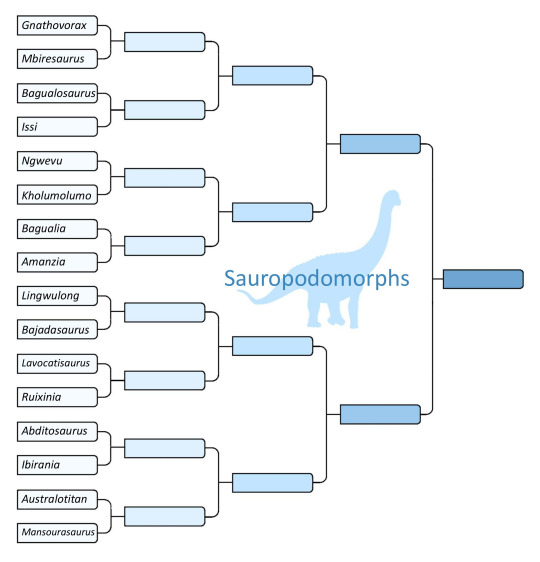
Gnathovorax vs Mbiresaurus
Bagualosaurus vs Issi
Ngwevu vs Kholumolumo
Bagualia vs Amanzia
Lingwulong vs Bajadasaurus
Lavocatisaurus vs Ruixinia
Abditosaurus vs Ibirania
Australotitan vs Mansourasaurus
ORNITHISCHIA
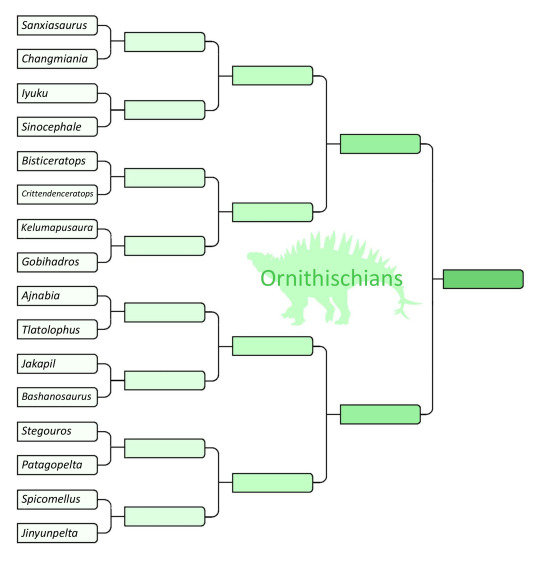
Sanxiasaurus vs Changmiania
Iyuku vs Sinocephale
Bisticeratops vs Crittendenceratops
Kelumapusaura vs Gobihadros
Ajnabia vs Tlatolophus
Jakapil vs Bashanosaurus
Stegouros vs Patagopelta
Spicomellus vs Jinyunpelta
NONAVIAN THEROPODA
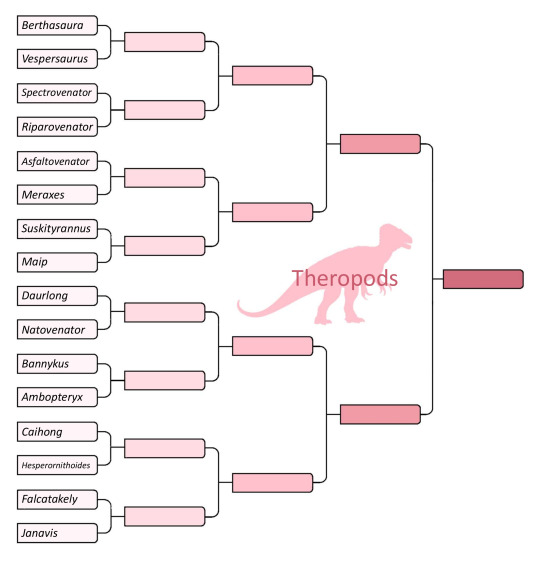
Berthasaura vs Vespersaurus
Spectrovenator vs Riparovenator
Asfaltovenator vs Meraxes
Suskityrannus vs Maip
Daurlong vs Natovenator
Bannykus vs Ambopteryx
Caihong vs Hesperornithoides
Falcatakely vs Janavis
NEORNITHES (BIRDS)

Vorombe vs Prodontopteryx
Asteriornis vs Panraogallus
Anachronornis vs Conflicto
Annakacygna vs Nasidytes
Aviraptor vs Cryptogyps
Miosurnia vs Primoptynx
Danielsraptor vs Heracles
Eofringillirostrum vs Heliothraupis
#dinosaur march madness#dmm#dmm rising stars#palaeoblr#dinosaurs#bracket#polls#march madness#tumblr dinosaur competition#thank you tumblr for making polls dmm is so much easier now I will cry#heliothraupis#eofringillirostrum#heracles#danielsraptor#primoptynx#miosurnia#cryptogyps#aviraptor#nasidytes#annakacygna#conflicto#anachronornis#panraogallus#asteriornis#prodontopteryx#vorombe#janavis#falcatakely#hesperornithoides#caihong
835 notes
·
View notes
Text
Izithakazelo zakwa Gwala
Izithakazelo zakwa Gwala | Gwala Clan Praise
Mphephethwa,
Nzimande,
Khondlwane,
Majiya,
Khamanga,
Mdlovu,
Mantshinga,
Ntimbane,
Ngwede,
Ngwevu,
Jili,
Ngwavuma,
Sihlase,
Vilakazi,
Gcuma,
Ngwekazi,
Mancama ngesinkw’esikhulu,
Wena owasukel’isigodo simuka nomfula uth’inyama,
Manda kulandulwa,
Vilakazi,
Xam’odla ngomsingizane,
Mhlandla!
Zikhona izikibha nama-jacket/hoodies akwa Hlengwa Whatsapp / call: 061 868 5163
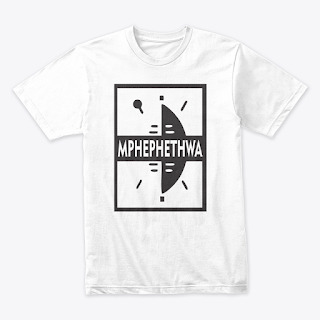
View On WordPress
#Gcuma#Gwala#Izithakazelo#Jili#Khamanga#Khondlwane#Majiya#Mantshinga#Mdlovu#Mphephethwa#Ngwavuma#Ngwede#Ngwekazi#Ngwevu#Ntimbane#Nzimande#Sihlase#VILAKAZI
0 notes
Text
I Know Dino Podcast Show Notes: Polacanthus (Episode 248)
I Know Dino Podcast Episode 248: The new sauropodomorph Ngwevu intloko from South Africa and tons of other news.
Episode 248 is all about Polacanthus, an ankylosaur that was described in the 1800s, but no one is sure who named it.
Big thanks to all our patrons! Your support means so much to us and keeps us going! If you’re a dinosaur enthusiast, join our growing community on Patreon at https://www.patreon.com/iknowdino.
You can listen to our free podcast, with all our episodes, on Apple Podcasts at:
View On WordPress
#animatronic#ankylosaur#australia#Blue#Cretaceous#Dampier#dinosaur#dinosaur of the day#dinosaurs#foxii#hadrosaur#i know dino#intloko#Isle of Skye#Isle of Wight#Jurassic#Legend of Isla Nubar#Lego Jurassic World#london#Mantellisaurus#maryland#massospondylus#Mission Jurassic#mongolia#Naturalis Biodiversity Center#Netherlands#Ngwevu#Nickelodeon#Paleozoic#Pipestone Creek
1 note
·
View note
Text
New species of early dinosaur described from South Africa
https://sciencespies.com/biology/new-species-of-early-dinosaur-described-from-south-africa/
New species of early dinosaur described from South Africa
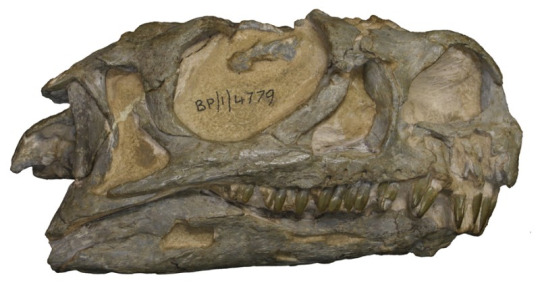

Ngwevu intloko skull. Credit: Kimberley Chapelle
A new dinosaur species has been discovered after laying misidentified in a museum collection for 30 years.
Prof Paul Barrett, a dinosaur researcher at the Natural History Museum, is part of a team that reassessed the specimen, which is held at the University of Witwatersrand, Johannesburg. Along with his colleagues in South Africa, and led by Paul’s Ph.D. student Kimberley Chapelle, they recognised it not only as a new species of sauropodomorph, but an entirely new genus. The specimen has now been named Ngwevu intloko which means “grey skull” in the Xhosa language, chosen to honour South Africa’s heritage.
Prof Barrett explains, “This is a new dinosaur that has been hiding in plain sight. “The specimen has been in the collections in Johannesburg for about 30 years, and lots of other scientists have already looked at it. But they all thought that it was simply an odd example of Massospondylus.”
Massospondylus was one of the first dinosaurs to reign at the start of the Jurassic period. Regularly found throughout southern Africa, these animals belonged to a group called the sauropodomorphs and eventually gave rise to the sauropods, a group containing the Natural History Museum’s iconic dinosaur cast Dippy. Researchers are now starting to look closer at many of the supposed Massospondylus specimens, believing there to be much more variation than first thought.
Kimberley Chapelle explains why the team were able to confirm that this specimen was a new species, “In order to be certain that a fossil belongs to a new species, it is crucial to rule out the possibility that it is a younger or older version of an already existing species. This is a difficult task to accomplish with fossils because it is rare to have a complete age series of fossils from a single species. Luckily, the most common South African dinosaur Massospondylus has specimens ranging from embryo to adult! Based on this, we were able to rule out age as a possible explanation for the differences we observed in the specimen now named Ngwevu intloko.”
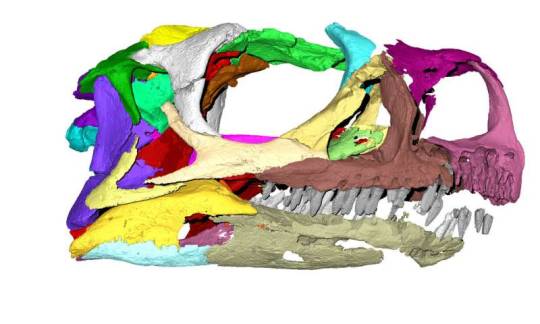
Micro-CT scan of Ngwevu intloko skull 2 . Credit: Kimberley Chapelle
The new dinosaur has been described from a single fairly complete specimen with a remarkably well-preserved skull. The new dinosaur was bipedal with a fairly chunky body, a long slender neck and a small, boxy head. It would have measured three metres from the tip of its snout to the end of its tail and was likely an omnivore, feeding on both plants and small animals.
The findings will help scientists better understand the transition between the Triassic and Jurassic period, around 200 million years ago. Known as a time of mass extinction it now seems that more complex ecosystems were flourishing in the earliest Jurassic than previously thought.
“This new species is interesting,” says Prof Barrett, ‘because we thought previously that there was really only one type of sauropodomorph living in South Africa at this time. We now know there were actually six or seven of these dinosaurs in this area, as well as variety of other dinosaurs from less common groups. It means that their ecology was much more complex than we used to think. Some of these other sauropodomorphs were like Massospondylus, but a few were close to the origins of true sauropods, if not true sauropods themselves.”
This work shows the value of revisiting specimens in museum collections, as many news species are probably sitting unnoticed in cabinets around the world.
The new paper “Ngwevu intloko: a new early sauropodomorph dinosaur from the Lower Jurassic Elliot Formation of South Africa and comments on cranial ontogeny in Massospondylus carinatus” is published in the journal PeerJ.
Explore further
CT-scan study makes it possible to 3-D print the skull of the dinosaur species massospondylus
More information:
Kimberley E.J. Chapelle et al. Ngwevu intloko: a new early sauropodomorph dinosaur from the Lower Jurassic Elliot Formation of South Africa and comments on cranial ontogeny in Massospondylus carinatus, PeerJ (2019). DOI: 10.7717/peerj.7240
Journal information:
PeerJ
Provided by
Natural History Museum
Citation:
New species of early dinosaur described from South Africa (2019, August 5)
retrieved 5 August 2019
from https://phys.org/news/2019-08-species-early-dinosaur-south-africa.html
This document is subject to copyright. Apart from any fair dealing for the purpose of private study or research, no
part may be reproduced without the written permission. The content is provided for information purposes only.
#Biology
0 notes